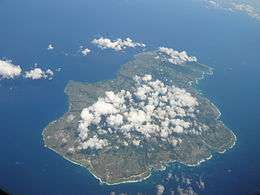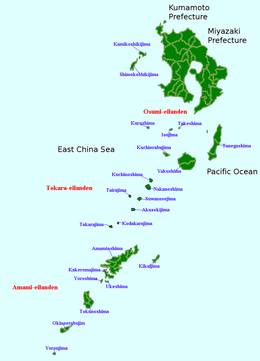Tokunoshima
| Native name: <span class="nickname" ">徳之島, Tokunoshima Tukunushima | |
|---|---|
 Aerial view of the island. (2011) | |
 | |
| Geography | |
| Location | East China Sea |
| Coordinates | 27°49′12″N 128°55′56″E / 27.82000°N 128.93222°ECoordinates: 27°49′12″N 128°55′56″E / 27.82000°N 128.93222°E |
| Archipelago | Amami Islands |
| Area | 247.77 km2 (95.66 sq mi) |
| Length | 25 km (15.5 mi) |
| Width | 18 km (11.2 mi) |
| Coastline | 80 km (50 mi) |
| Highest elevation | 645 m (2,116 ft) |
| Highest point | Inokawadake |
| Administration | |
|
Japan | |
| Prefectures | Kagoshima Prefecture |
| District | Ōshima District |
| Demographics | |
| Population | 27,000 (2013) |
| Pop. density | 108.97 /km2 (282.23 /sq mi) |
| Ethnic groups | Japanese |
Tokunoshima (Japanese: 徳之島, Amami: トゥクヌシマ, Tukunushima), also known in English as Tokunoshima Island and Tokuno Island, is one of the Satsunan Islands, classed with the Amami archipelago between Kyūshū and Okinawa.[1]
The island, 247.77 km2 (95.66 sq mi) in area, has a population of approximately 27,000. Administratively it is divided into the three towns of Tokunoshima, Isen, and Amagi in Kagoshima Prefecture. Much of the island is within the borders of the Amami Guntō Quasi-National Park.
Geography
Tokunoshima is isolated from the other Amami islands, and is located halfway between Amami Oshima and Okinoerabujima, approximately 489 kilometers (264 nmi) south of the southern tip of Kyūshū and 100 kilometres (54 nmi) north of Okinawa.
The island is of volcanic origin with a length of approximately 25 kilometers (16 mi) and width of 18 kilometers (11 mi), with Mount Inokawadake at 645 meters (2,116 ft) above sea level at its highest peak. Mount Amagidake in the north has a height of 533 meters (1,749 ft). The coast of the island is surrounded by a coral reef.
The island is covered with forests of laurel, but has been extensively cleared for agriculture. There are many caves on the island, the longest of which measures 2,052 meters (6,732 ft) and is located in the area of Isen.
The climate of Tokunoshima is classified as a humid subtropical climate (Köppen climate classification Cfa) with very warm summers and mild winters. The rainy season lasts from May through September. The island is subject to frequent typhoons.
Fauna
Tokunoshima is home to several rare species endemic to the island itself, or more generally to the Ryukyu archipelago. The Amami rabbit is found only on Tokunoshima and Amami-Ōshima and is listed as endangered. Also endangered is the Tokunoshima spiny rat, found only on the island.
History
It is uncertain when Tokunoshima was first settled. It is mentioned in the ancient Japanese chronicle Nihon Shoki in the 720s. Until 1624, Tokunoshima was part of the Ryukyu Kingdom and was famous for a unique form of bullfighting called Tōgyū. The island was invaded by samurai from Satsuma Domain in 1609 and its incorporation into the official holdings of that domain was recognized by the Tokugawa shogunate in 1624. Satsuma rule was harsh, with the inhabitants of the island reduced to serfdom and forced to raise sugar cane to meet high taxation, which often resulted in famine. In a famine in 1755, some 3000 islanders perished. Saigo Takamori was exiled to Tokunoshima in 1862 for less than two months, before he was resentenced to harsher conditions on Okinoerabujima. After the Meiji Restoration it was incorporated into Ōsumi Province and later became part of Kagoshima Prefecture. Following World War II, with the other Amami Islands, it was occupied by the United States until 1953, at which time it reverted to the control of Japan. In 2006, Prime Minister Yukio Hatoyama offered the use of Tokunoshima to the United States as a relocation site for Marine Corps Air Station Futenma, leading to widespread protests.
Transportation
The port of Kametoku, located in the town of Tokunoshima has regular ferry service to Okinawa, Kagoshima and Kobe. The smaller port of Hetono, in the town of Amagi, has ferries to Kagoshima and Amami. Tokunoshima Airport, located in Amagi, is connected to Kagoshima and Amami by Japan Air Commuter.
Local attractions
Tokunoshima is a popular tourist destination. Hiking is discouraged because of the habu snake, but the mountain trails are exotic and beautiful. The beaches are also quite stunning, and there is a strange shore on the island's north in which the open sea crashes against massive flat stone slabs.
At Cape Intabu, the westernmost point of the island, is a memorial to the battleship Yamato and her escorts, which were sunk near Tokunoshima during the final stages of World War II.
References
- ↑ Teikoku's Complete Atlas of Japan, Teikoku-Shoin Co., Ltd., Tokyo, ISBN 4-8071-0004-1
- Eldridge, Mark. The Return of the Amami Islands: The Reversion Movement and U.S.-Japan Relations. Levington Books (2004) ISBN 0739107100
- Hellyer. Robert. Defining Engagement: Japan and Global Contexts, 1640-1868. Harvard University Press (2009) ISBN 0674035771
- Turnbull, Stephen. The Most Daring Raid of the Samurai. Rosen Publishing Group (2011) ISBN 978-1-4488-1872-3
- Ravina, Mark. The Last Samurai: The Life and Battles of Saigo Takamori. Whiley (2011) ISBN 1118045564
- Yeo, Andrew. Activists, Alliances, and Anti-U.S. Base Protests. Cambridge University Press. (2011) ISBN 1107002478
External links
| Wikimedia Commons has media related to Tokunoshima. |